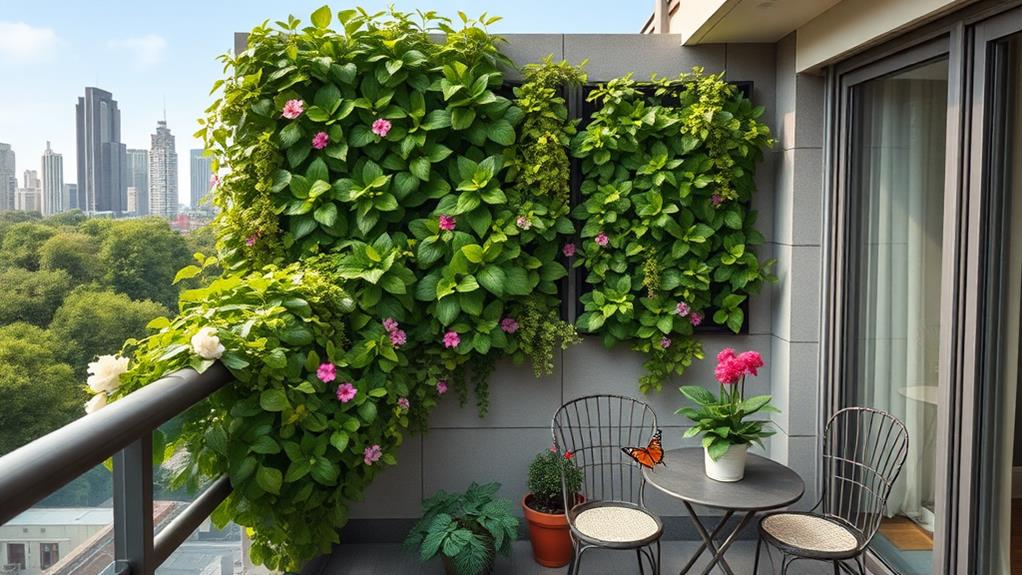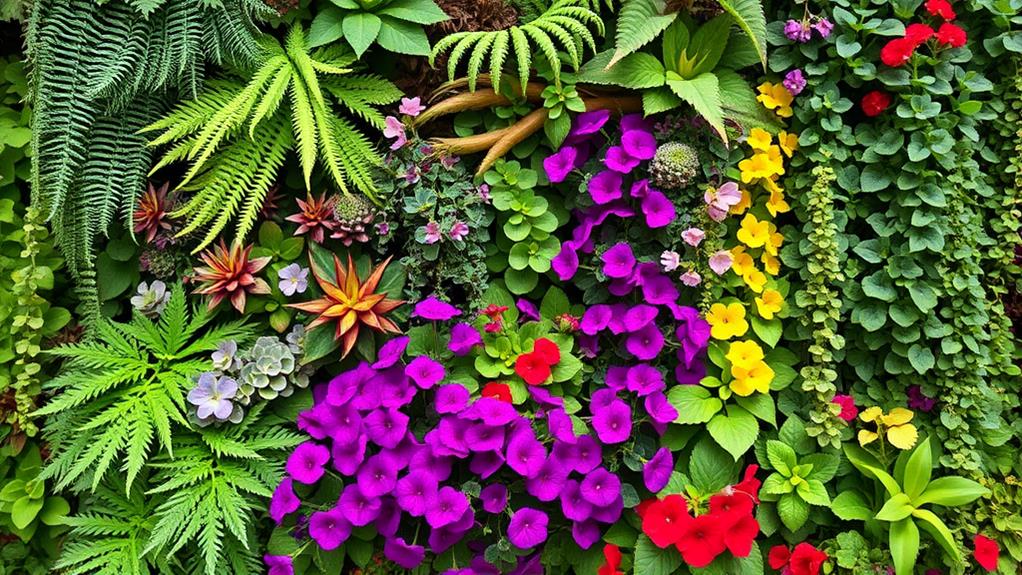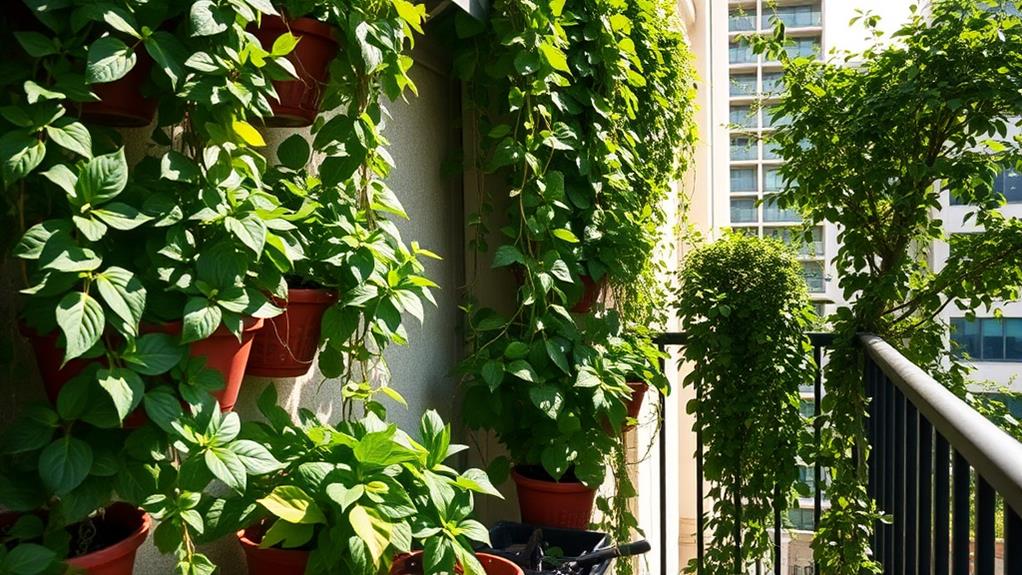Vertical gardens offer an innovative solution for maximizing limited outdoor spaces in urban environments. These upward-growing installations not only enhance aesthetic appeal but also improve air quality and provide thermal insulation. When choosing a system, consider space, weight limitations, and maintenance requirements. Ideal plants include succulents, herbs, ferns, and trailing varieties. DIY enthusiasts can create vertical gardens using pallets, hanging pockets, or repurposed materials. Proper care involves efficient irrigation, regular fertilization, and pruning. With the right approach, even the smallest balcony or patio can be transformed into a lush, green oasis. Exploring vertical gardening techniques can unlock a world of possibilities for your compact outdoor area.
Benefits of Vertical Gardens

Vertical gardens offer four key benefits that make them increasingly popular in urban environments. First, they maximize space utilization, allowing gardeners to grow plants vertically in areas with limited horizontal surface area. This is particularly advantageous for apartment dwellers, small businesses, and urban homeowners with compact outdoor spaces.
Second, vertical gardens contribute to improved air quality. Plants act as natural air purifiers, absorbing pollutants and releasing oxygen, which is especially beneficial in densely populated urban areas.
Third, these gardens provide thermal insulation for buildings, reducing energy costs associated with heating and cooling. The plant layers create a barrier that helps regulate indoor temperatures, leading to increased energy efficiency.
Lastly, vertical gardens enhance aesthetic appeal and promote biodiversity. They transform dull walls and fences into vibrant, living canvases that attract pollinators and small wildlife. This not only beautifies urban spaces but also supports local ecosystems. Additionally, the presence of greenery has been shown to reduce stress and improve overall well-being for city residents, making vertical gardens a valuable addition to any urban environment.
Choosing the Right System
Success in creating a thriving vertical garden hinges on selecting the most appropriate system for your specific needs and environment. Consider factors such as available space, weight limitations, sunlight exposure, and maintenance requirements when choosing a vertical garden system.
Pocket systems, consisting of fabric pockets attached to a frame, are lightweight and ideal for small spaces. They work well for herbs and smaller plants but may dry out quickly. Modular panel systems offer flexibility and easy plant replacement, making them suitable for larger installations or frequent design changes. Hydroponic systems, while more complex, provide efficient water and nutrient delivery, ideal for growing vegetables and larger plants.
For DIY enthusiasts, repurposed materials like pallets or recycled containers can create unique, cost-effective vertical gardens. However, ensure proper drainage and structural integrity. Living walls, featuring integrated irrigation systems and specialized growing media, offer a professional look but require more investment and expertise to install and maintain.
Consider the long-term maintenance requirements of each system, including watering frequency, fertilization needs, and potential plant replacement. Ultimately, the right vertical garden system should align with your gardening goals, aesthetic preferences, and available resources.
Best Plants for Vertical Gardens

Selecting the right plants is crucial for a thriving vertical garden. Consider factors such as sunlight exposure, water requirements, and growth habits when choosing plants.
Succulents and air plants are excellent choices for low-maintenance vertical gardens, as they require minimal water and can thrive in various light conditions. Popular succulent options include echeveria, sedum, and burro's tail.
For vertical gardens with more sunlight, herbs like basil, mint, and thyme are ideal. These not only add greenery but also provide fresh ingredients for cooking. Ferns, such as Boston fern and bird's nest fern, work well in shadier areas and add a lush, tropical feel. Trailing plants like pothos, string of pearls, and ivy create a cascading effect that enhances the visual appeal of vertical gardens.
For those seeking colorful options, consider flowering plants like petunias, impatiens, or begonias. These add vibrant hues and visual interest to your vertical space. When selecting plants, ensure they have similar care requirements if grouped together, and choose varieties that won't outgrow their designated spaces quickly.
DIY Vertical Garden Projects
Embarking on a DIY vertical garden project can be both rewarding and cost-effective for home gardeners. With minimal materials and creativity, you can transform unused vertical spaces into lush, green oases.
One popular DIY option is the pallet garden, which repurposes wooden pallets into multi-tiered planters. Simply secure landscape fabric to the back, fill with soil, and plant your chosen flora.
Another easy project is the hanging pocket garden, using shoe organizers or specially designed fabric pockets. These can be hung on walls or fences, providing ample space for herbs, succulents, or small flowering plants. For a more structured look, consider building a ladder planter using reclaimed wood or PVC pipes. This design allows for easy customization and can be moved as needed.
Recycled materials like tin cans, plastic bottles, or old gutters can also be transformed into unique vertical planters. With proper drainage and mounting, these unconventional containers can add character to any space. For those with limited floor space, a tension rod garden suspended between walls or in a window frame offers a creative solution for growing plants vertically without permanent fixtures.
Maintenance and Care Tips

Three key aspects of maintaining a thriving vertical garden are proper watering, nutrient management, and regular pruning. Watering frequency depends on plant types, climate, and garden structure. Most vertical gardens benefit from a drip irrigation system, which ensures consistent moisture without oversaturation. Monitor soil moisture levels regularly and adjust watering accordingly.
Nutrient management is crucial for plant health. Use a balanced, water-soluble fertilizer appropriate for your plants, applying it every 2-4 weeks during the growing season. Slow-release fertilizers can also be incorporated into the growing medium for long-term nourishment.
Pruning maintains plant shape, promotes growth, and prevents overcrowding. Trim dead or yellowing leaves, pinch back leggy stems, and remove any diseased portions promptly. This practice also improves air circulation, reducing the risk of fungal diseases.
Regularly inspect your vertical garden for pests and diseases. Address issues quickly using organic or chemical treatments as needed. Clean the garden structure periodically to prevent mold and algae growth. Replace or refresh growing media annually to maintain optimal soil conditions and prevent nutrient depletion. With consistent care, your vertical garden will flourish, providing a lush, vibrant display in your small outdoor space.
Frequently Asked Questions
Can Vertical Gardens Attract Pests or Create Moisture Problems on Walls?
Vertical gardens can potentially attract pests and create moisture issues on walls. Proper design, installation, and maintenance are crucial to prevent these problems. Regular inspections, adequate drainage, and appropriate plant selection can minimize risks associated with vertical gardening.
How Much Weight Can a Vertical Garden Add to a Structure?
The weight of a vertical garden can be staggeringly immense! Depending on the design, plants, and irrigation system, it can add anywhere from 20 to 150 pounds per square foot. Proper structural assessment is crucial before installation.
Are There Any Legal Considerations for Installing Vertical Gardens in Rental Properties?
Legal considerations for installing vertical gardens in rental properties typically involve obtaining landlord approval, adhering to lease agreements, and ensuring structural integrity. Tenants should consult local building codes and obtain necessary permits to avoid potential legal issues.
Can Vertical Gardens Be Used for Growing Edible Plants and Herbs?
Imagine a green tapestry of sustenance adorning your walls. Indeed, these living canvases can be utilized for cultivating edible flora. With proper planning and care, one can successfully grow a variety of herbs and vegetables in vertical garden systems.
How Do Vertical Gardens Impact Property Values and Curb Appeal?
Vertical gardens can significantly enhance property values and curb appeal. They add aesthetic appeal, create green spaces in urban environments, and demonstrate eco-friendly living. This unique feature can attract potential buyers and increase a property's marketability.
Conclusion
Vertical gardens symbolize humanity's resilience and adaptability in the face of urban constraints. These living walls represent a harmonious fusion of nature and architecture, offering a beacon of hope for sustainable urban living. As concrete jungles continue to expand, vertical gardens stand as verdant oases, purifying air and nurturing biodiversity. By embracing these skyward sanctuaries, urban dwellers can cultivate a greener future, transforming barren facades into thriving ecosystems that reach towards the heavens, defying spatial limitations.

